Project Management Methodologies: Benefits, Issues, and Solutions
VerifiedAdded on 2019/10/30
|16
|3354
|298
Report
AI Summary
This report delves into the practical application of project management methodologies, focusing on PMBOK, PRINCE2, and Waterfall, through three distinct case studies. It analyzes the implementation strategies for each methodology within different organizational structures, considering factors like employee strength and industry type. The report meticulously outlines the benefits derived from each methodology, such as process standardization and improved risk management, while also identifying potential issues like change management challenges and the need for flexibility. Furthermore, it proposes targeted solutions to mitigate these issues, including assigning roles and responsibilities, enhancing risk management processes, and adapting models to real-world scenarios. By examining the advantages, disadvantages, and solutions, the report provides a comprehensive understanding of how to effectively apply these methodologies to enhance project success.
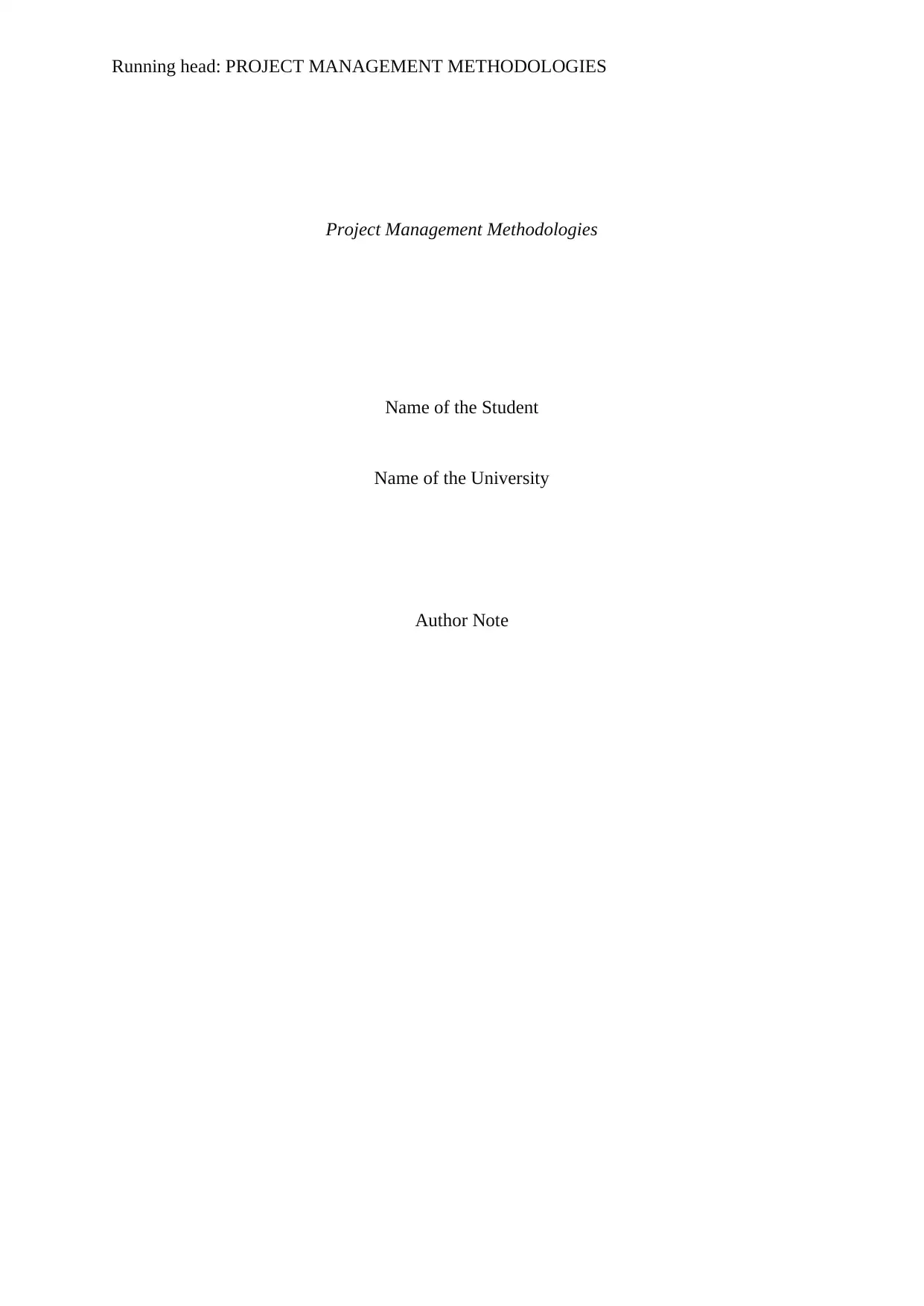
Running head: PROJECT MANAGEMENT METHODOLOGIES
Project Management Methodologies
Name of the Student
Name of the University
Author Note
Project Management Methodologies
Name of the Student
Name of the University
Author Note
Paraphrase This Document
Need a fresh take? Get an instant paraphrase of this document with our AI Paraphraser
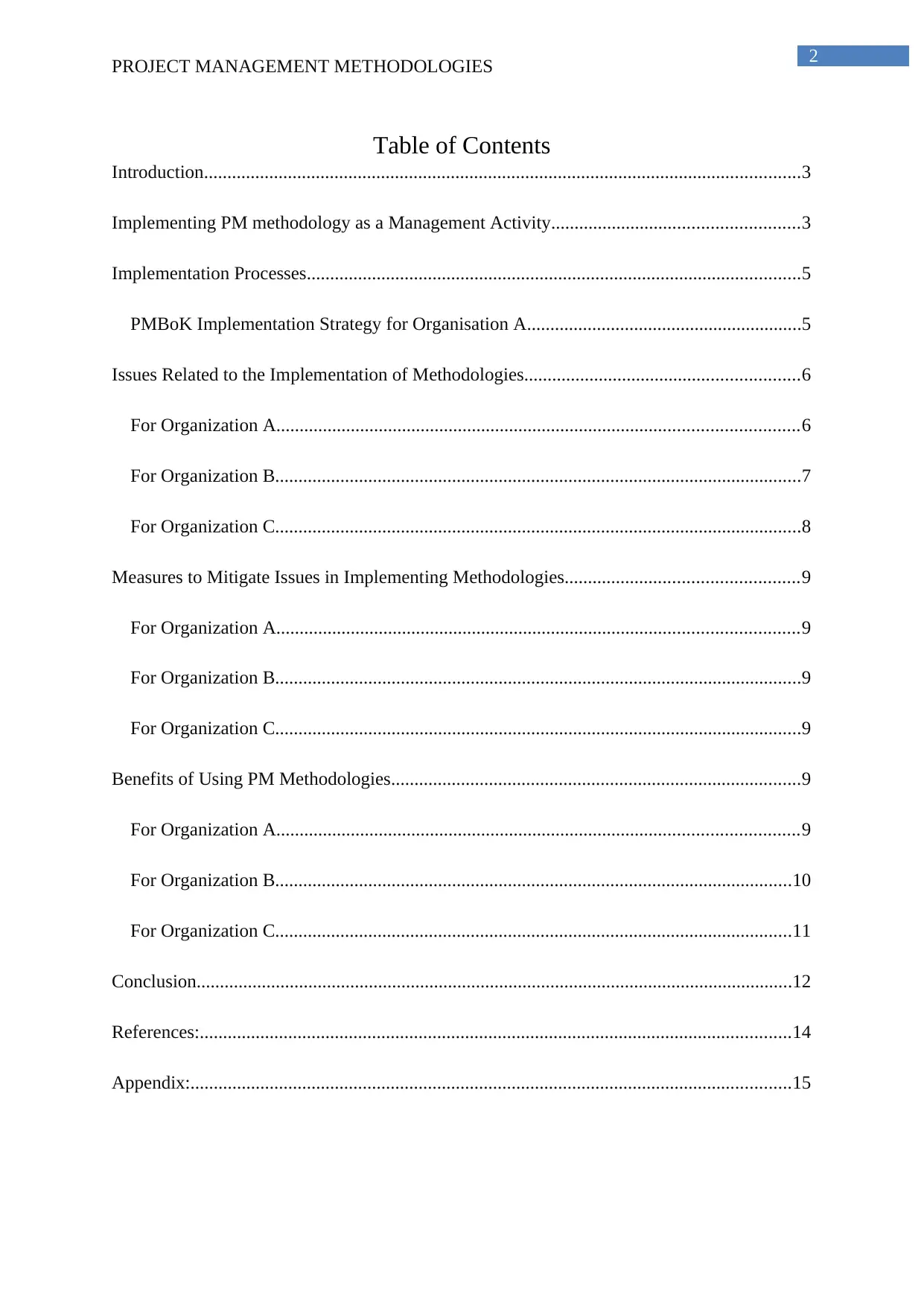
2
PROJECT MANAGEMENT METHODOLOGIES
Table of Contents
Introduction................................................................................................................................3
Implementing PM methodology as a Management Activity.....................................................3
Implementation Processes..........................................................................................................5
PMBoK Implementation Strategy for Organisation A...........................................................5
Issues Related to the Implementation of Methodologies...........................................................6
For Organization A................................................................................................................6
For Organization B.................................................................................................................7
For Organization C.................................................................................................................8
Measures to Mitigate Issues in Implementing Methodologies..................................................9
For Organization A................................................................................................................9
For Organization B.................................................................................................................9
For Organization C.................................................................................................................9
Benefits of Using PM Methodologies........................................................................................9
For Organization A................................................................................................................9
For Organization B...............................................................................................................10
For Organization C...............................................................................................................11
Conclusion................................................................................................................................12
References:...............................................................................................................................14
Appendix:.................................................................................................................................15
PROJECT MANAGEMENT METHODOLOGIES
Table of Contents
Introduction................................................................................................................................3
Implementing PM methodology as a Management Activity.....................................................3
Implementation Processes..........................................................................................................5
PMBoK Implementation Strategy for Organisation A...........................................................5
Issues Related to the Implementation of Methodologies...........................................................6
For Organization A................................................................................................................6
For Organization B.................................................................................................................7
For Organization C.................................................................................................................8
Measures to Mitigate Issues in Implementing Methodologies..................................................9
For Organization A................................................................................................................9
For Organization B.................................................................................................................9
For Organization C.................................................................................................................9
Benefits of Using PM Methodologies........................................................................................9
For Organization A................................................................................................................9
For Organization B...............................................................................................................10
For Organization C...............................................................................................................11
Conclusion................................................................................................................................12
References:...............................................................................................................................14
Appendix:.................................................................................................................................15
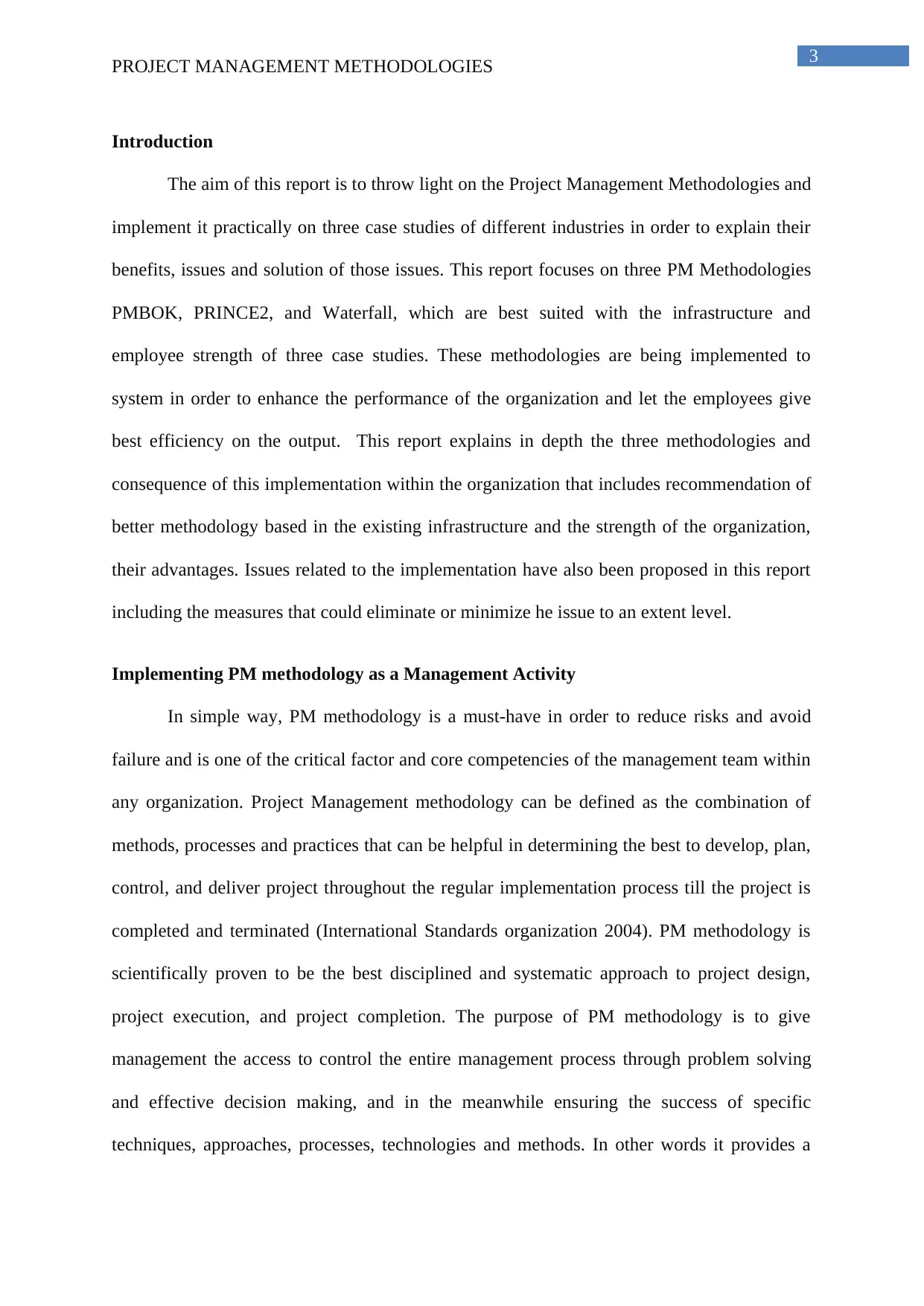
3
PROJECT MANAGEMENT METHODOLOGIES
Introduction
The aim of this report is to throw light on the Project Management Methodologies and
implement it practically on three case studies of different industries in order to explain their
benefits, issues and solution of those issues. This report focuses on three PM Methodologies
PMBOK, PRINCE2, and Waterfall, which are best suited with the infrastructure and
employee strength of three case studies. These methodologies are being implemented to
system in order to enhance the performance of the organization and let the employees give
best efficiency on the output. This report explains in depth the three methodologies and
consequence of this implementation within the organization that includes recommendation of
better methodology based in the existing infrastructure and the strength of the organization,
their advantages. Issues related to the implementation have also been proposed in this report
including the measures that could eliminate or minimize he issue to an extent level.
Implementing PM methodology as a Management Activity
In simple way, PM methodology is a must-have in order to reduce risks and avoid
failure and is one of the critical factor and core competencies of the management team within
any organization. Project Management methodology can be defined as the combination of
methods, processes and practices that can be helpful in determining the best to develop, plan,
control, and deliver project throughout the regular implementation process till the project is
completed and terminated (International Standards organization 2004). PM methodology is
scientifically proven to be the best disciplined and systematic approach to project design,
project execution, and project completion. The purpose of PM methodology is to give
management the access to control the entire management process through problem solving
and effective decision making, and in the meanwhile ensuring the success of specific
techniques, approaches, processes, technologies and methods. In other words it provides a
PROJECT MANAGEMENT METHODOLOGIES
Introduction
The aim of this report is to throw light on the Project Management Methodologies and
implement it practically on three case studies of different industries in order to explain their
benefits, issues and solution of those issues. This report focuses on three PM Methodologies
PMBOK, PRINCE2, and Waterfall, which are best suited with the infrastructure and
employee strength of three case studies. These methodologies are being implemented to
system in order to enhance the performance of the organization and let the employees give
best efficiency on the output. This report explains in depth the three methodologies and
consequence of this implementation within the organization that includes recommendation of
better methodology based in the existing infrastructure and the strength of the organization,
their advantages. Issues related to the implementation have also been proposed in this report
including the measures that could eliminate or minimize he issue to an extent level.
Implementing PM methodology as a Management Activity
In simple way, PM methodology is a must-have in order to reduce risks and avoid
failure and is one of the critical factor and core competencies of the management team within
any organization. Project Management methodology can be defined as the combination of
methods, processes and practices that can be helpful in determining the best to develop, plan,
control, and deliver project throughout the regular implementation process till the project is
completed and terminated (International Standards organization 2004). PM methodology is
scientifically proven to be the best disciplined and systematic approach to project design,
project execution, and project completion. The purpose of PM methodology is to give
management the access to control the entire management process through problem solving
and effective decision making, and in the meanwhile ensuring the success of specific
techniques, approaches, processes, technologies and methods. In other words it provides a
⊘ This is a preview!⊘
Do you want full access?
Subscribe today to unlock all pages.

Trusted by 1+ million students worldwide
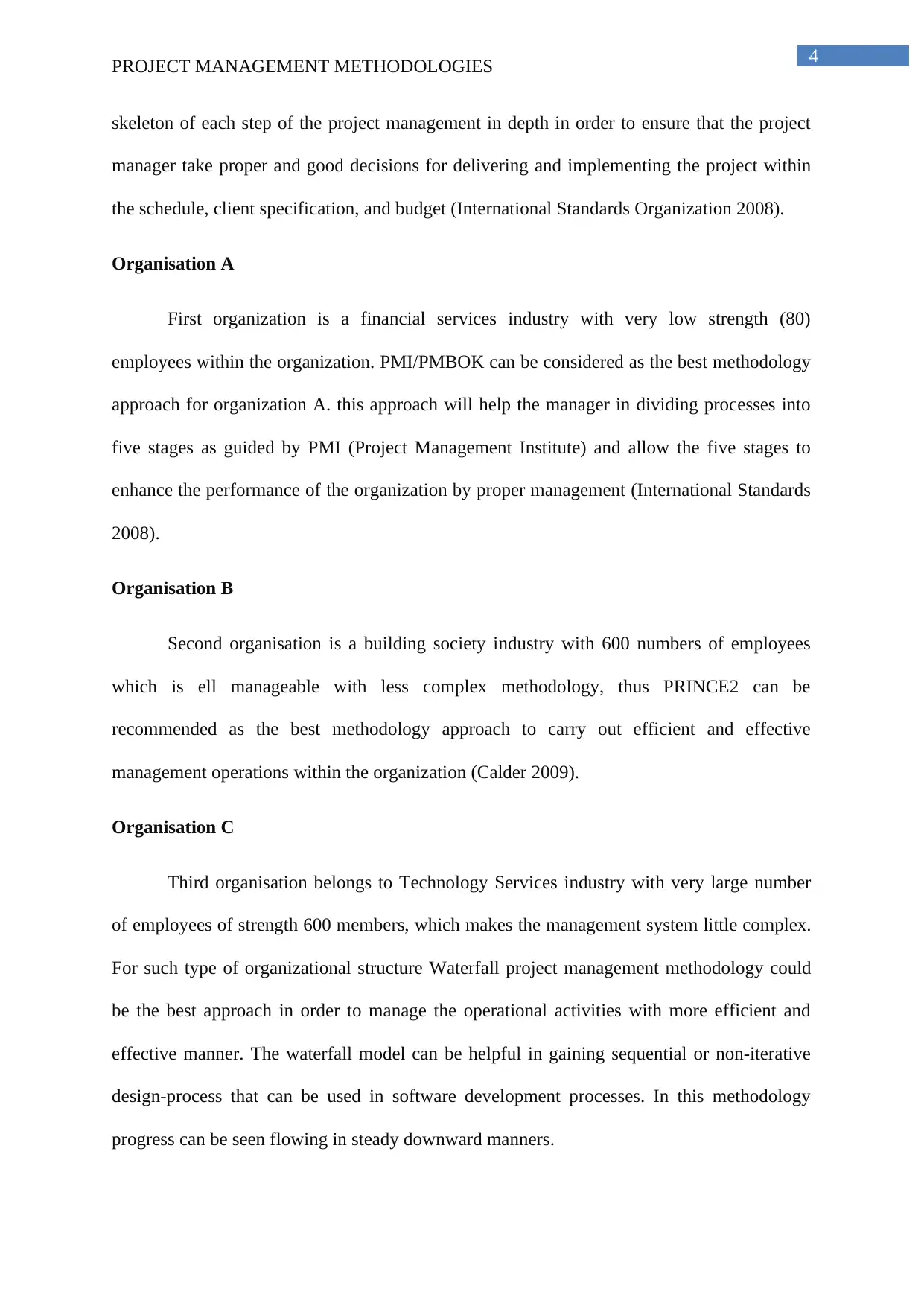
4
PROJECT MANAGEMENT METHODOLOGIES
skeleton of each step of the project management in depth in order to ensure that the project
manager take proper and good decisions for delivering and implementing the project within
the schedule, client specification, and budget (International Standards Organization 2008).
Organisation A
First organization is a financial services industry with very low strength (80)
employees within the organization. PMI/PMBOK can be considered as the best methodology
approach for organization A. this approach will help the manager in dividing processes into
five stages as guided by PMI (Project Management Institute) and allow the five stages to
enhance the performance of the organization by proper management (International Standards
2008).
Organisation B
Second organisation is a building society industry with 600 numbers of employees
which is ell manageable with less complex methodology, thus PRINCE2 can be
recommended as the best methodology approach to carry out efficient and effective
management operations within the organization (Calder 2009).
Organisation C
Third organisation belongs to Technology Services industry with very large number
of employees of strength 600 members, which makes the management system little complex.
For such type of organizational structure Waterfall project management methodology could
be the best approach in order to manage the operational activities with more efficient and
effective manner. The waterfall model can be helpful in gaining sequential or non-iterative
design-process that can be used in software development processes. In this methodology
progress can be seen flowing in steady downward manners.
PROJECT MANAGEMENT METHODOLOGIES
skeleton of each step of the project management in depth in order to ensure that the project
manager take proper and good decisions for delivering and implementing the project within
the schedule, client specification, and budget (International Standards Organization 2008).
Organisation A
First organization is a financial services industry with very low strength (80)
employees within the organization. PMI/PMBOK can be considered as the best methodology
approach for organization A. this approach will help the manager in dividing processes into
five stages as guided by PMI (Project Management Institute) and allow the five stages to
enhance the performance of the organization by proper management (International Standards
2008).
Organisation B
Second organisation is a building society industry with 600 numbers of employees
which is ell manageable with less complex methodology, thus PRINCE2 can be
recommended as the best methodology approach to carry out efficient and effective
management operations within the organization (Calder 2009).
Organisation C
Third organisation belongs to Technology Services industry with very large number
of employees of strength 600 members, which makes the management system little complex.
For such type of organizational structure Waterfall project management methodology could
be the best approach in order to manage the operational activities with more efficient and
effective manner. The waterfall model can be helpful in gaining sequential or non-iterative
design-process that can be used in software development processes. In this methodology
progress can be seen flowing in steady downward manners.
Paraphrase This Document
Need a fresh take? Get an instant paraphrase of this document with our AI Paraphraser
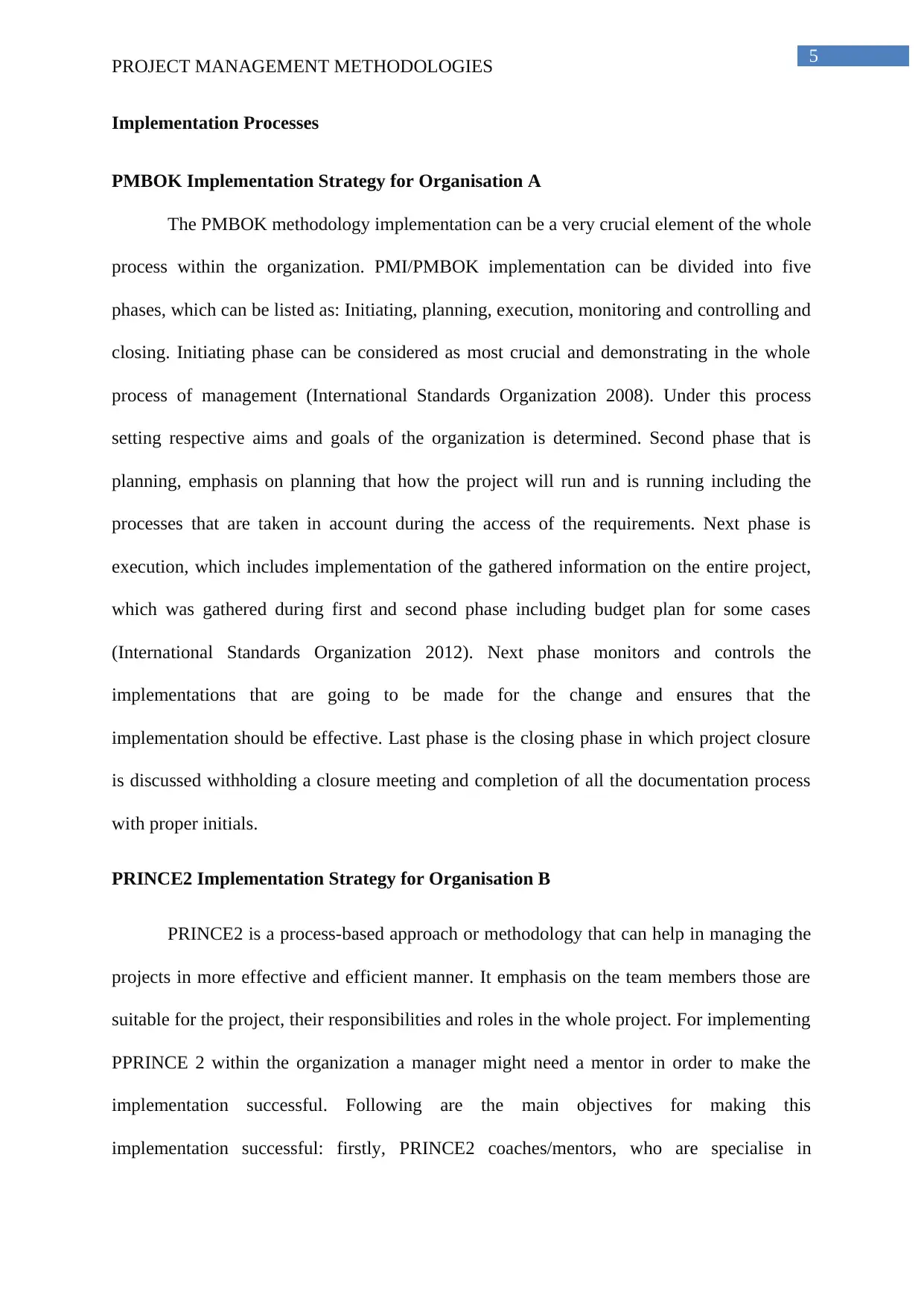
5
PROJECT MANAGEMENT METHODOLOGIES
Implementation Processes
PMBOK Implementation Strategy for Organisation A
The PMBOK methodology implementation can be a very crucial element of the whole
process within the organization. PMI/PMBOK implementation can be divided into five
phases, which can be listed as: Initiating, planning, execution, monitoring and controlling and
closing. Initiating phase can be considered as most crucial and demonstrating in the whole
process of management (International Standards Organization 2008). Under this process
setting respective aims and goals of the organization is determined. Second phase that is
planning, emphasis on planning that how the project will run and is running including the
processes that are taken in account during the access of the requirements. Next phase is
execution, which includes implementation of the gathered information on the entire project,
which was gathered during first and second phase including budget plan for some cases
(International Standards Organization 2012). Next phase monitors and controls the
implementations that are going to be made for the change and ensures that the
implementation should be effective. Last phase is the closing phase in which project closure
is discussed withholding a closure meeting and completion of all the documentation process
with proper initials.
PRINCE2 Implementation Strategy for Organisation B
PRINCE2 is a process-based approach or methodology that can help in managing the
projects in more effective and efficient manner. It emphasis on the team members those are
suitable for the project, their responsibilities and roles in the whole project. For implementing
PPRINCE 2 within the organization a manager might need a mentor in order to make the
implementation successful. Following are the main objectives for making this
implementation successful: firstly, PRINCE2 coaches/mentors, who are specialise in
PROJECT MANAGEMENT METHODOLOGIES
Implementation Processes
PMBOK Implementation Strategy for Organisation A
The PMBOK methodology implementation can be a very crucial element of the whole
process within the organization. PMI/PMBOK implementation can be divided into five
phases, which can be listed as: Initiating, planning, execution, monitoring and controlling and
closing. Initiating phase can be considered as most crucial and demonstrating in the whole
process of management (International Standards Organization 2008). Under this process
setting respective aims and goals of the organization is determined. Second phase that is
planning, emphasis on planning that how the project will run and is running including the
processes that are taken in account during the access of the requirements. Next phase is
execution, which includes implementation of the gathered information on the entire project,
which was gathered during first and second phase including budget plan for some cases
(International Standards Organization 2012). Next phase monitors and controls the
implementations that are going to be made for the change and ensures that the
implementation should be effective. Last phase is the closing phase in which project closure
is discussed withholding a closure meeting and completion of all the documentation process
with proper initials.
PRINCE2 Implementation Strategy for Organisation B
PRINCE2 is a process-based approach or methodology that can help in managing the
projects in more effective and efficient manner. It emphasis on the team members those are
suitable for the project, their responsibilities and roles in the whole project. For implementing
PPRINCE 2 within the organization a manager might need a mentor in order to make the
implementation successful. Following are the main objectives for making this
implementation successful: firstly, PRINCE2 coaches/mentors, who are specialise in
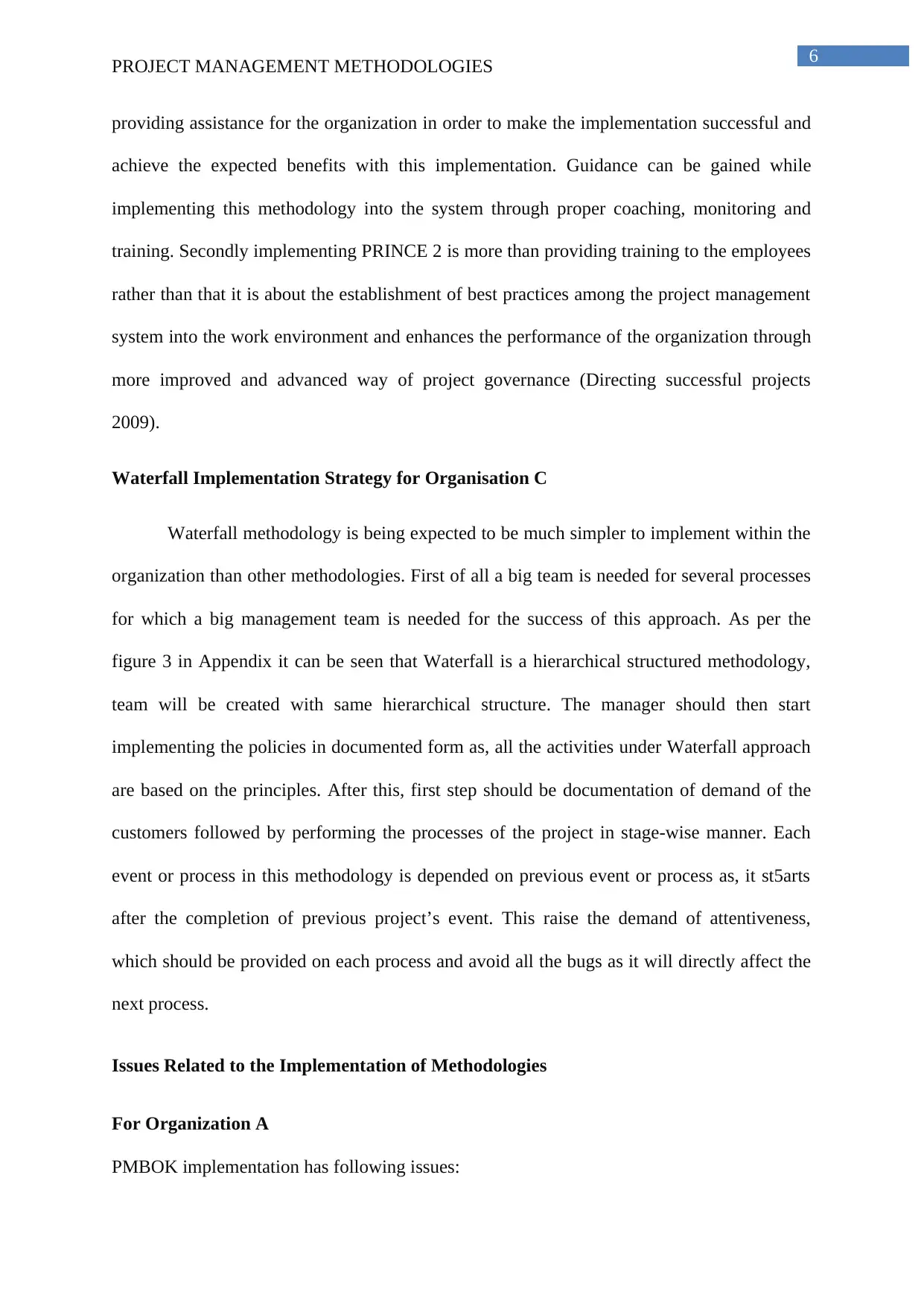
6
PROJECT MANAGEMENT METHODOLOGIES
providing assistance for the organization in order to make the implementation successful and
achieve the expected benefits with this implementation. Guidance can be gained while
implementing this methodology into the system through proper coaching, monitoring and
training. Secondly implementing PRINCE 2 is more than providing training to the employees
rather than that it is about the establishment of best practices among the project management
system into the work environment and enhances the performance of the organization through
more improved and advanced way of project governance (Directing successful projects
2009).
Waterfall Implementation Strategy for Organisation C
Waterfall methodology is being expected to be much simpler to implement within the
organization than other methodologies. First of all a big team is needed for several processes
for which a big management team is needed for the success of this approach. As per the
figure 3 in Appendix it can be seen that Waterfall is a hierarchical structured methodology,
team will be created with same hierarchical structure. The manager should then start
implementing the policies in documented form as, all the activities under Waterfall approach
are based on the principles. After this, first step should be documentation of demand of the
customers followed by performing the processes of the project in stage-wise manner. Each
event or process in this methodology is depended on previous event or process as, it st5arts
after the completion of previous project’s event. This raise the demand of attentiveness,
which should be provided on each process and avoid all the bugs as it will directly affect the
next process.
Issues Related to the Implementation of Methodologies
For Organization A
PMBOK implementation has following issues:
PROJECT MANAGEMENT METHODOLOGIES
providing assistance for the organization in order to make the implementation successful and
achieve the expected benefits with this implementation. Guidance can be gained while
implementing this methodology into the system through proper coaching, monitoring and
training. Secondly implementing PRINCE 2 is more than providing training to the employees
rather than that it is about the establishment of best practices among the project management
system into the work environment and enhances the performance of the organization through
more improved and advanced way of project governance (Directing successful projects
2009).
Waterfall Implementation Strategy for Organisation C
Waterfall methodology is being expected to be much simpler to implement within the
organization than other methodologies. First of all a big team is needed for several processes
for which a big management team is needed for the success of this approach. As per the
figure 3 in Appendix it can be seen that Waterfall is a hierarchical structured methodology,
team will be created with same hierarchical structure. The manager should then start
implementing the policies in documented form as, all the activities under Waterfall approach
are based on the principles. After this, first step should be documentation of demand of the
customers followed by performing the processes of the project in stage-wise manner. Each
event or process in this methodology is depended on previous event or process as, it st5arts
after the completion of previous project’s event. This raise the demand of attentiveness,
which should be provided on each process and avoid all the bugs as it will directly affect the
next process.
Issues Related to the Implementation of Methodologies
For Organization A
PMBOK implementation has following issues:
⊘ This is a preview!⊘
Do you want full access?
Subscribe today to unlock all pages.

Trusted by 1+ million students worldwide
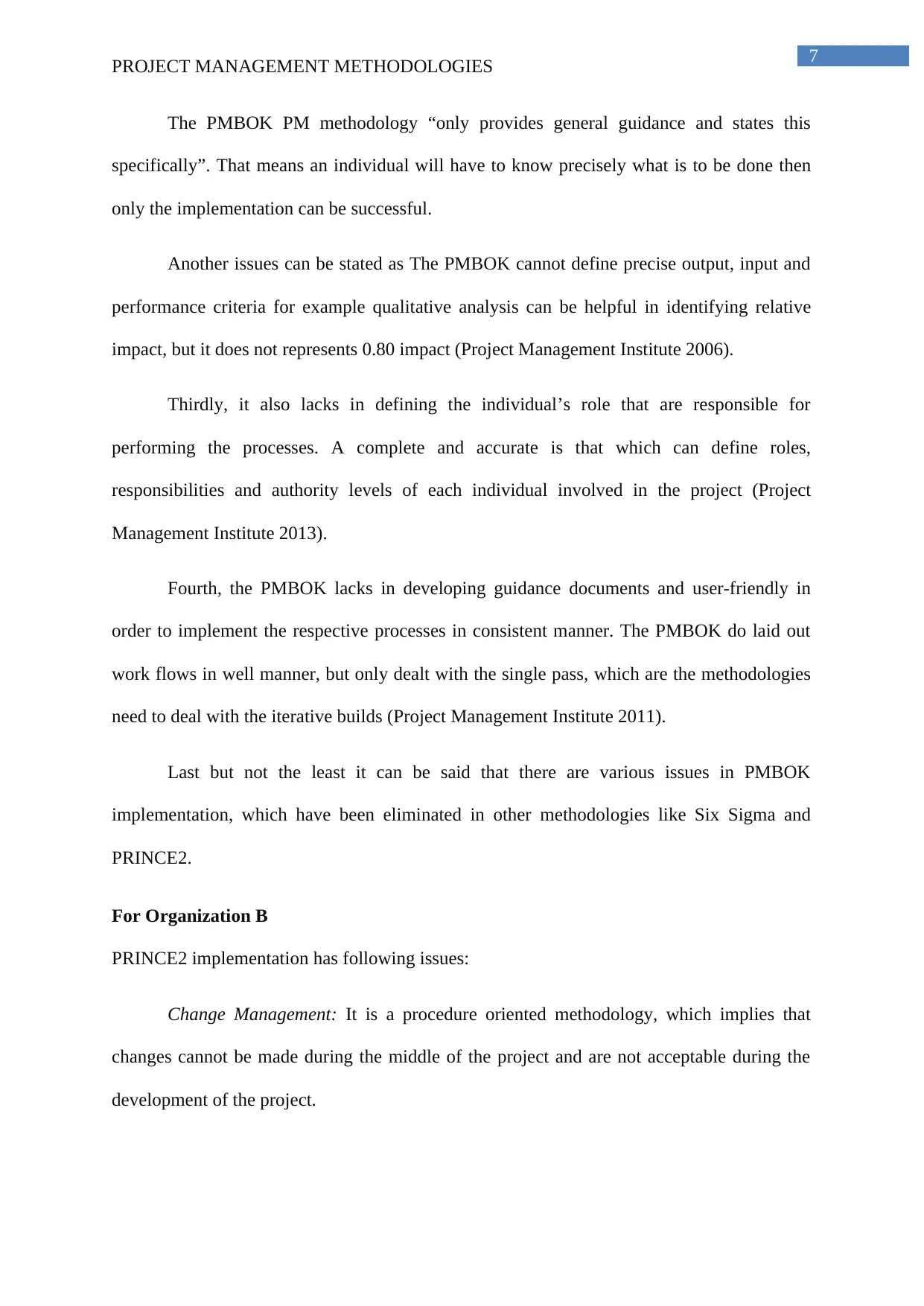
7
PROJECT MANAGEMENT METHODOLOGIES
The PMBOK PM methodology “only provides general guidance and states this
specifically”. That means an individual will have to know precisely what is to be done then
only the implementation can be successful.
Another issues can be stated as The PMBOK cannot define precise output, input and
performance criteria for example qualitative analysis can be helpful in identifying relative
impact, but it does not represents 0.80 impact (Project Management Institute 2006).
Thirdly, it also lacks in defining the individual’s role that are responsible for
performing the processes. A complete and accurate is that which can define roles,
responsibilities and authority levels of each individual involved in the project (Project
Management Institute 2013).
Fourth, the PMBOK lacks in developing guidance documents and user-friendly in
order to implement the respective processes in consistent manner. The PMBOK do laid out
work flows in well manner, but only dealt with the single pass, which are the methodologies
need to deal with the iterative builds (Project Management Institute 2011).
Last but not the least it can be said that there are various issues in PMBOK
implementation, which have been eliminated in other methodologies like Six Sigma and
PRINCE2.
For Organization B
PRINCE2 implementation has following issues:
Change Management: It is a procedure oriented methodology, which implies that
changes cannot be made during the middle of the project and are not acceptable during the
development of the project.
PROJECT MANAGEMENT METHODOLOGIES
The PMBOK PM methodology “only provides general guidance and states this
specifically”. That means an individual will have to know precisely what is to be done then
only the implementation can be successful.
Another issues can be stated as The PMBOK cannot define precise output, input and
performance criteria for example qualitative analysis can be helpful in identifying relative
impact, but it does not represents 0.80 impact (Project Management Institute 2006).
Thirdly, it also lacks in defining the individual’s role that are responsible for
performing the processes. A complete and accurate is that which can define roles,
responsibilities and authority levels of each individual involved in the project (Project
Management Institute 2013).
Fourth, the PMBOK lacks in developing guidance documents and user-friendly in
order to implement the respective processes in consistent manner. The PMBOK do laid out
work flows in well manner, but only dealt with the single pass, which are the methodologies
need to deal with the iterative builds (Project Management Institute 2011).
Last but not the least it can be said that there are various issues in PMBOK
implementation, which have been eliminated in other methodologies like Six Sigma and
PRINCE2.
For Organization B
PRINCE2 implementation has following issues:
Change Management: It is a procedure oriented methodology, which implies that
changes cannot be made during the middle of the project and are not acceptable during the
development of the project.
Paraphrase This Document
Need a fresh take? Get an instant paraphrase of this document with our AI Paraphraser
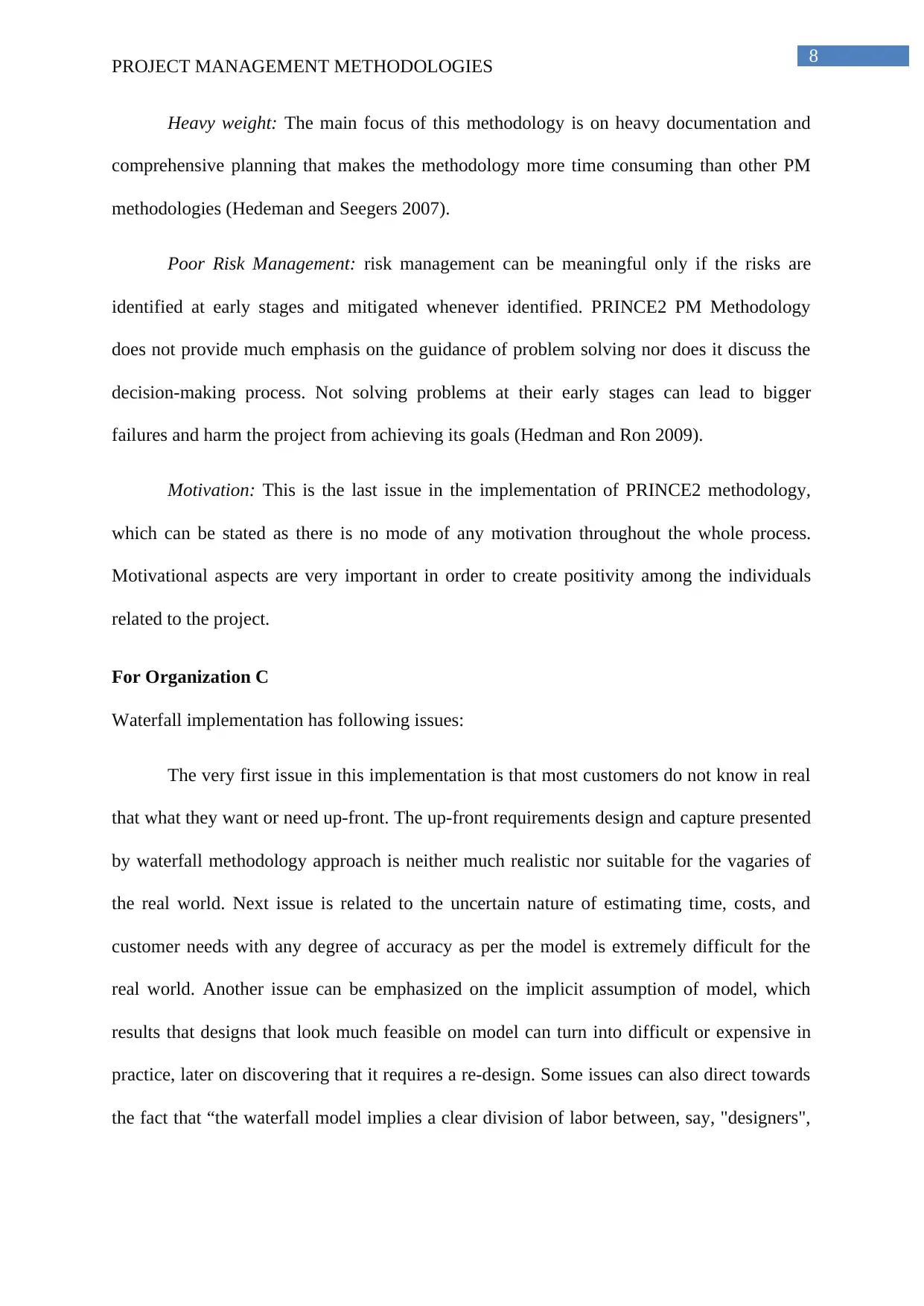
8
PROJECT MANAGEMENT METHODOLOGIES
Heavy weight: The main focus of this methodology is on heavy documentation and
comprehensive planning that makes the methodology more time consuming than other PM
methodologies (Hedeman and Seegers 2007).
Poor Risk Management: risk management can be meaningful only if the risks are
identified at early stages and mitigated whenever identified. PRINCE2 PM Methodology
does not provide much emphasis on the guidance of problem solving nor does it discuss the
decision-making process. Not solving problems at their early stages can lead to bigger
failures and harm the project from achieving its goals (Hedman and Ron 2009).
Motivation: This is the last issue in the implementation of PRINCE2 methodology,
which can be stated as there is no mode of any motivation throughout the whole process.
Motivational aspects are very important in order to create positivity among the individuals
related to the project.
For Organization C
Waterfall implementation has following issues:
The very first issue in this implementation is that most customers do not know in real
that what they want or need up-front. The up-front requirements design and capture presented
by waterfall methodology approach is neither much realistic nor suitable for the vagaries of
the real world. Next issue is related to the uncertain nature of estimating time, costs, and
customer needs with any degree of accuracy as per the model is extremely difficult for the
real world. Another issue can be emphasized on the implicit assumption of model, which
results that designs that look much feasible on model can turn into difficult or expensive in
practice, later on discovering that it requires a re-design. Some issues can also direct towards
the fact that “the waterfall model implies a clear division of labor between, say, "designers",
PROJECT MANAGEMENT METHODOLOGIES
Heavy weight: The main focus of this methodology is on heavy documentation and
comprehensive planning that makes the methodology more time consuming than other PM
methodologies (Hedeman and Seegers 2007).
Poor Risk Management: risk management can be meaningful only if the risks are
identified at early stages and mitigated whenever identified. PRINCE2 PM Methodology
does not provide much emphasis on the guidance of problem solving nor does it discuss the
decision-making process. Not solving problems at their early stages can lead to bigger
failures and harm the project from achieving its goals (Hedman and Ron 2009).
Motivation: This is the last issue in the implementation of PRINCE2 methodology,
which can be stated as there is no mode of any motivation throughout the whole process.
Motivational aspects are very important in order to create positivity among the individuals
related to the project.
For Organization C
Waterfall implementation has following issues:
The very first issue in this implementation is that most customers do not know in real
that what they want or need up-front. The up-front requirements design and capture presented
by waterfall methodology approach is neither much realistic nor suitable for the vagaries of
the real world. Next issue is related to the uncertain nature of estimating time, costs, and
customer needs with any degree of accuracy as per the model is extremely difficult for the
real world. Another issue can be emphasized on the implicit assumption of model, which
results that designs that look much feasible on model can turn into difficult or expensive in
practice, later on discovering that it requires a re-design. Some issues can also direct towards
the fact that “the waterfall model implies a clear division of labor between, say, "designers",
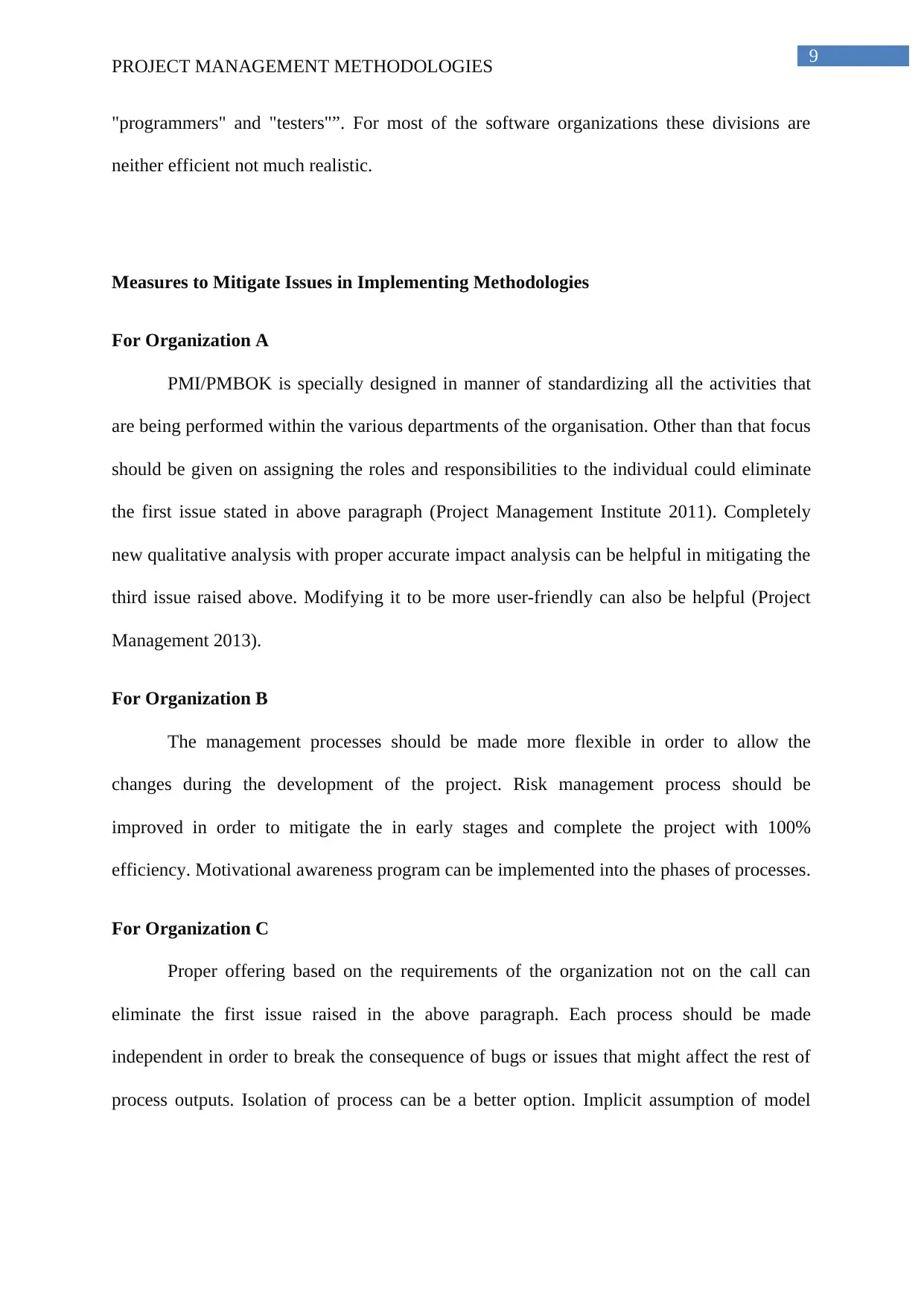
9
PROJECT MANAGEMENT METHODOLOGIES
"programmers" and "testers"”. For most of the software organizations these divisions are
neither efficient not much realistic.
Measures to Mitigate Issues in Implementing Methodologies
For Organization A
PMI/PMBOK is specially designed in manner of standardizing all the activities that
are being performed within the various departments of the organisation. Other than that focus
should be given on assigning the roles and responsibilities to the individual could eliminate
the first issue stated in above paragraph (Project Management Institute 2011). Completely
new qualitative analysis with proper accurate impact analysis can be helpful in mitigating the
third issue raised above. Modifying it to be more user-friendly can also be helpful (Project
Management 2013).
For Organization B
The management processes should be made more flexible in order to allow the
changes during the development of the project. Risk management process should be
improved in order to mitigate the in early stages and complete the project with 100%
efficiency. Motivational awareness program can be implemented into the phases of processes.
For Organization C
Proper offering based on the requirements of the organization not on the call can
eliminate the first issue raised in the above paragraph. Each process should be made
independent in order to break the consequence of bugs or issues that might affect the rest of
process outputs. Isolation of process can be a better option. Implicit assumption of model
PROJECT MANAGEMENT METHODOLOGIES
"programmers" and "testers"”. For most of the software organizations these divisions are
neither efficient not much realistic.
Measures to Mitigate Issues in Implementing Methodologies
For Organization A
PMI/PMBOK is specially designed in manner of standardizing all the activities that
are being performed within the various departments of the organisation. Other than that focus
should be given on assigning the roles and responsibilities to the individual could eliminate
the first issue stated in above paragraph (Project Management Institute 2011). Completely
new qualitative analysis with proper accurate impact analysis can be helpful in mitigating the
third issue raised above. Modifying it to be more user-friendly can also be helpful (Project
Management 2013).
For Organization B
The management processes should be made more flexible in order to allow the
changes during the development of the project. Risk management process should be
improved in order to mitigate the in early stages and complete the project with 100%
efficiency. Motivational awareness program can be implemented into the phases of processes.
For Organization C
Proper offering based on the requirements of the organization not on the call can
eliminate the first issue raised in the above paragraph. Each process should be made
independent in order to break the consequence of bugs or issues that might affect the rest of
process outputs. Isolation of process can be a better option. Implicit assumption of model
⊘ This is a preview!⊘
Do you want full access?
Subscribe today to unlock all pages.

Trusted by 1+ million students worldwide
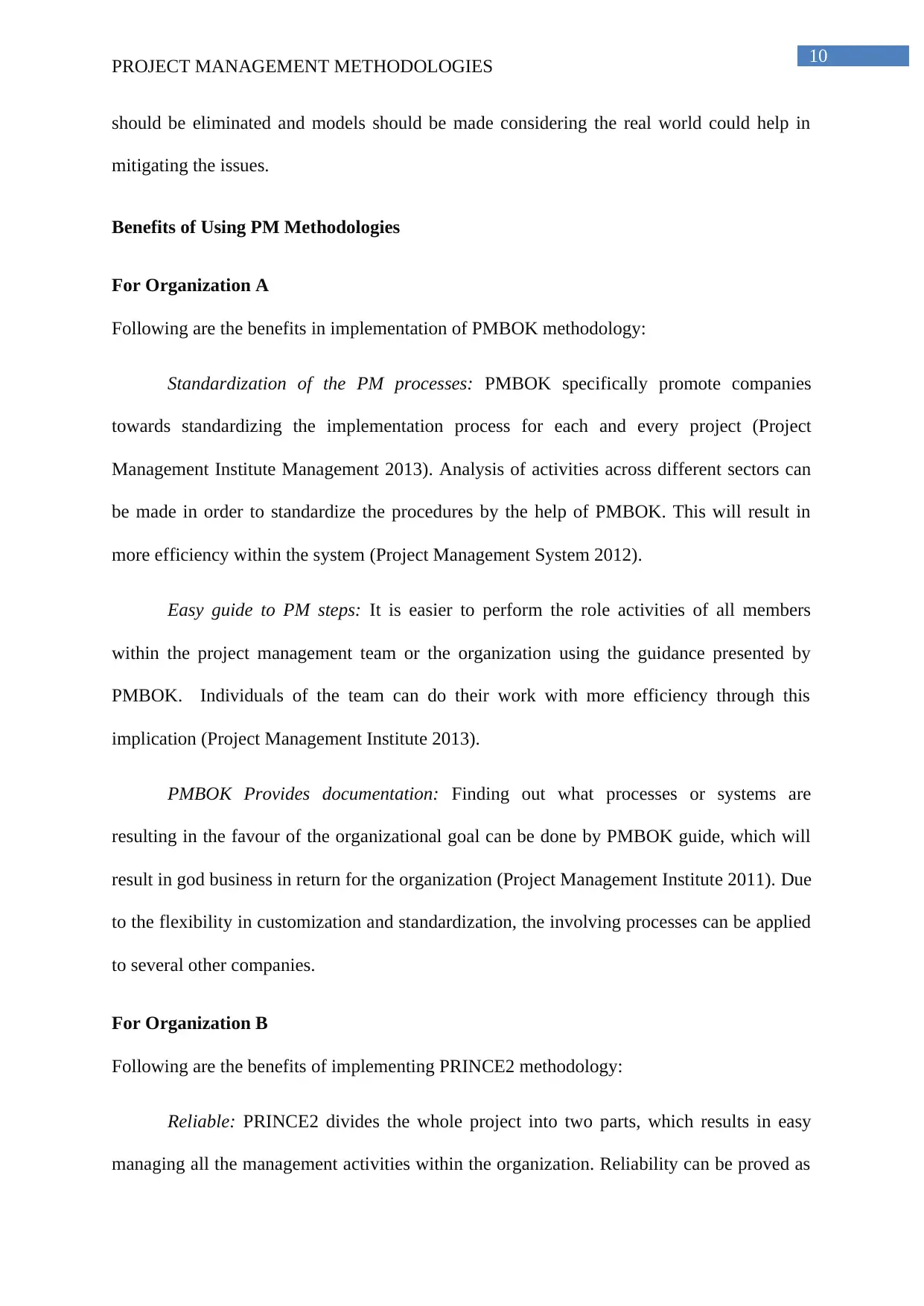
10
PROJECT MANAGEMENT METHODOLOGIES
should be eliminated and models should be made considering the real world could help in
mitigating the issues.
Benefits of Using PM Methodologies
For Organization A
Following are the benefits in implementation of PMBOK methodology:
Standardization of the PM processes: PMBOK specifically promote companies
towards standardizing the implementation process for each and every project (Project
Management Institute Management 2013). Analysis of activities across different sectors can
be made in order to standardize the procedures by the help of PMBOK. This will result in
more efficiency within the system (Project Management System 2012).
Easy guide to PM steps: It is easier to perform the role activities of all members
within the project management team or the organization using the guidance presented by
PMBOK. Individuals of the team can do their work with more efficiency through this
implication (Project Management Institute 2013).
PMBOK Provides documentation: Finding out what processes or systems are
resulting in the favour of the organizational goal can be done by PMBOK guide, which will
result in god business in return for the organization (Project Management Institute 2011). Due
to the flexibility in customization and standardization, the involving processes can be applied
to several other companies.
For Organization B
Following are the benefits of implementing PRINCE2 methodology:
Reliable: PRINCE2 divides the whole project into two parts, which results in easy
managing all the management activities within the organization. Reliability can be proved as
PROJECT MANAGEMENT METHODOLOGIES
should be eliminated and models should be made considering the real world could help in
mitigating the issues.
Benefits of Using PM Methodologies
For Organization A
Following are the benefits in implementation of PMBOK methodology:
Standardization of the PM processes: PMBOK specifically promote companies
towards standardizing the implementation process for each and every project (Project
Management Institute Management 2013). Analysis of activities across different sectors can
be made in order to standardize the procedures by the help of PMBOK. This will result in
more efficiency within the system (Project Management System 2012).
Easy guide to PM steps: It is easier to perform the role activities of all members
within the project management team or the organization using the guidance presented by
PMBOK. Individuals of the team can do their work with more efficiency through this
implication (Project Management Institute 2013).
PMBOK Provides documentation: Finding out what processes or systems are
resulting in the favour of the organizational goal can be done by PMBOK guide, which will
result in god business in return for the organization (Project Management Institute 2011). Due
to the flexibility in customization and standardization, the involving processes can be applied
to several other companies.
For Organization B
Following are the benefits of implementing PRINCE2 methodology:
Reliable: PRINCE2 divides the whole project into two parts, which results in easy
managing all the management activities within the organization. Reliability can be proved as
Paraphrase This Document
Need a fresh take? Get an instant paraphrase of this document with our AI Paraphraser
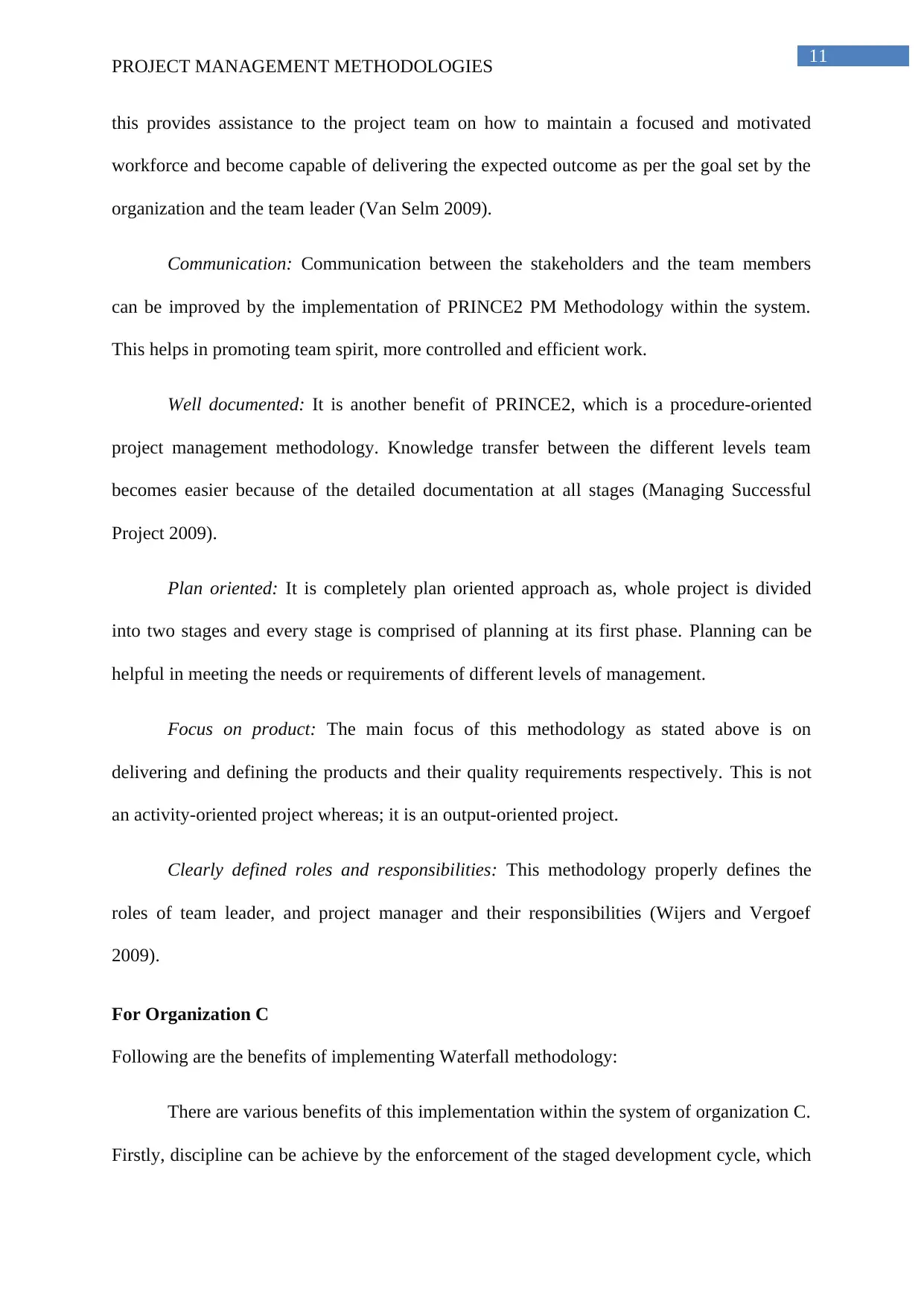
11
PROJECT MANAGEMENT METHODOLOGIES
this provides assistance to the project team on how to maintain a focused and motivated
workforce and become capable of delivering the expected outcome as per the goal set by the
organization and the team leader (Van Selm 2009).
Communication: Communication between the stakeholders and the team members
can be improved by the implementation of PRINCE2 PM Methodology within the system.
This helps in promoting team spirit, more controlled and efficient work.
Well documented: It is another benefit of PRINCE2, which is a procedure-oriented
project management methodology. Knowledge transfer between the different levels team
becomes easier because of the detailed documentation at all stages (Managing Successful
Project 2009).
Plan oriented: It is completely plan oriented approach as, whole project is divided
into two stages and every stage is comprised of planning at its first phase. Planning can be
helpful in meeting the needs or requirements of different levels of management.
Focus on product: The main focus of this methodology as stated above is on
delivering and defining the products and their quality requirements respectively. This is not
an activity-oriented project whereas; it is an output-oriented project.
Clearly defined roles and responsibilities: This methodology properly defines the
roles of team leader, and project manager and their responsibilities (Wijers and Vergoef
2009).
For Organization C
Following are the benefits of implementing Waterfall methodology:
There are various benefits of this implementation within the system of organization C.
Firstly, discipline can be achieve by the enforcement of the staged development cycle, which
PROJECT MANAGEMENT METHODOLOGIES
this provides assistance to the project team on how to maintain a focused and motivated
workforce and become capable of delivering the expected outcome as per the goal set by the
organization and the team leader (Van Selm 2009).
Communication: Communication between the stakeholders and the team members
can be improved by the implementation of PRINCE2 PM Methodology within the system.
This helps in promoting team spirit, more controlled and efficient work.
Well documented: It is another benefit of PRINCE2, which is a procedure-oriented
project management methodology. Knowledge transfer between the different levels team
becomes easier because of the detailed documentation at all stages (Managing Successful
Project 2009).
Plan oriented: It is completely plan oriented approach as, whole project is divided
into two stages and every stage is comprised of planning at its first phase. Planning can be
helpful in meeting the needs or requirements of different levels of management.
Focus on product: The main focus of this methodology as stated above is on
delivering and defining the products and their quality requirements respectively. This is not
an activity-oriented project whereas; it is an output-oriented project.
Clearly defined roles and responsibilities: This methodology properly defines the
roles of team leader, and project manager and their responsibilities (Wijers and Vergoef
2009).
For Organization C
Following are the benefits of implementing Waterfall methodology:
There are various benefits of this implementation within the system of organization C.
Firstly, discipline can be achieve by the enforcement of the staged development cycle, which
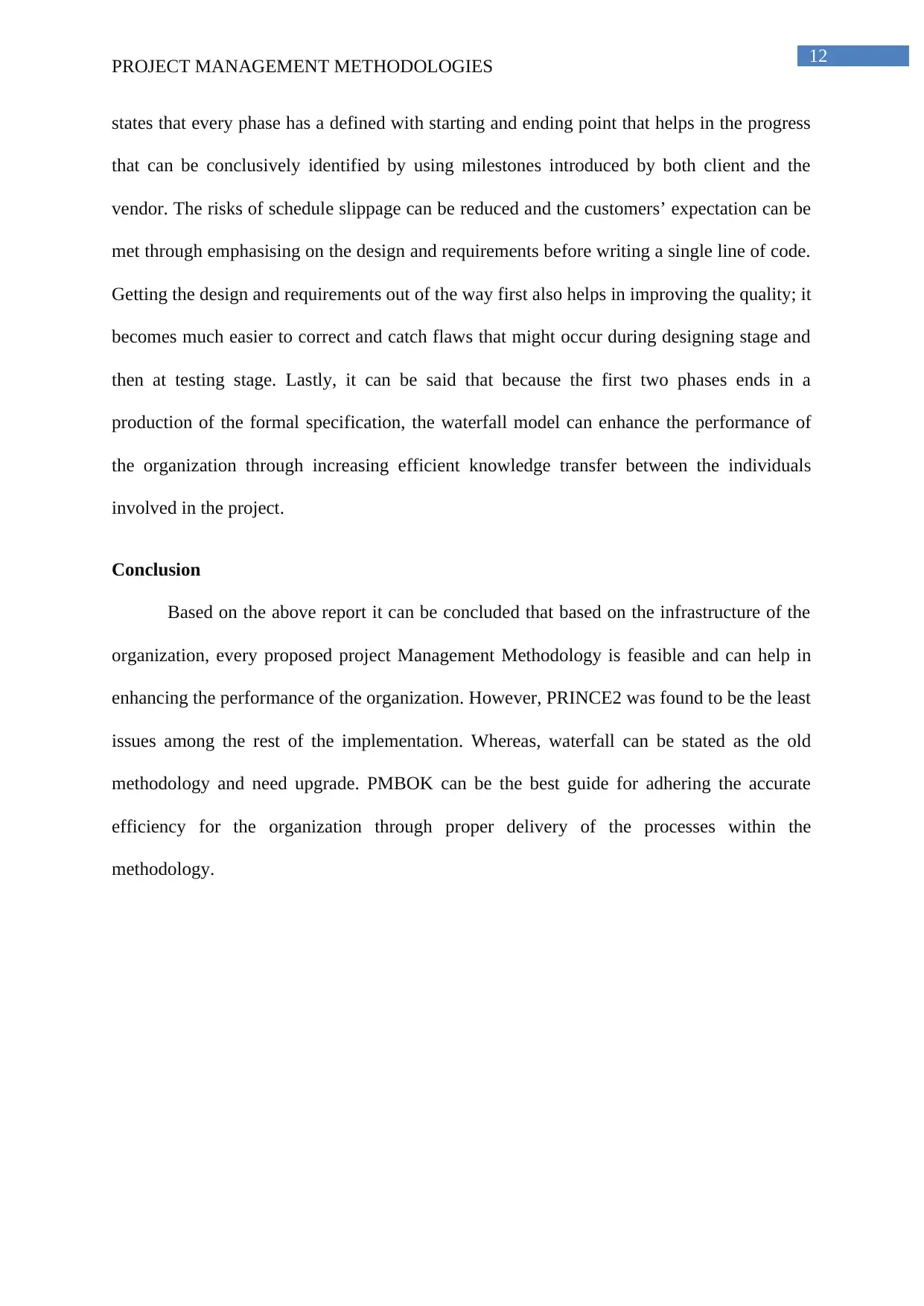
12
PROJECT MANAGEMENT METHODOLOGIES
states that every phase has a defined with starting and ending point that helps in the progress
that can be conclusively identified by using milestones introduced by both client and the
vendor. The risks of schedule slippage can be reduced and the customers’ expectation can be
met through emphasising on the design and requirements before writing a single line of code.
Getting the design and requirements out of the way first also helps in improving the quality; it
becomes much easier to correct and catch flaws that might occur during designing stage and
then at testing stage. Lastly, it can be said that because the first two phases ends in a
production of the formal specification, the waterfall model can enhance the performance of
the organization through increasing efficient knowledge transfer between the individuals
involved in the project.
Conclusion
Based on the above report it can be concluded that based on the infrastructure of the
organization, every proposed project Management Methodology is feasible and can help in
enhancing the performance of the organization. However, PRINCE2 was found to be the least
issues among the rest of the implementation. Whereas, waterfall can be stated as the old
methodology and need upgrade. PMBOK can be the best guide for adhering the accurate
efficiency for the organization through proper delivery of the processes within the
methodology.
PROJECT MANAGEMENT METHODOLOGIES
states that every phase has a defined with starting and ending point that helps in the progress
that can be conclusively identified by using milestones introduced by both client and the
vendor. The risks of schedule slippage can be reduced and the customers’ expectation can be
met through emphasising on the design and requirements before writing a single line of code.
Getting the design and requirements out of the way first also helps in improving the quality; it
becomes much easier to correct and catch flaws that might occur during designing stage and
then at testing stage. Lastly, it can be said that because the first two phases ends in a
production of the formal specification, the waterfall model can enhance the performance of
the organization through increasing efficient knowledge transfer between the individuals
involved in the project.
Conclusion
Based on the above report it can be concluded that based on the infrastructure of the
organization, every proposed project Management Methodology is feasible and can help in
enhancing the performance of the organization. However, PRINCE2 was found to be the least
issues among the rest of the implementation. Whereas, waterfall can be stated as the old
methodology and need upgrade. PMBOK can be the best guide for adhering the accurate
efficiency for the organization through proper delivery of the processes within the
methodology.
⊘ This is a preview!⊘
Do you want full access?
Subscribe today to unlock all pages.

Trusted by 1+ million students worldwide
1 out of 16
Related Documents
Your All-in-One AI-Powered Toolkit for Academic Success.
+13062052269
info@desklib.com
Available 24*7 on WhatsApp / Email
![[object Object]](/_next/static/media/star-bottom.7253800d.svg)
Unlock your academic potential
Copyright © 2020–2025 A2Z Services. All Rights Reserved. Developed and managed by ZUCOL.





